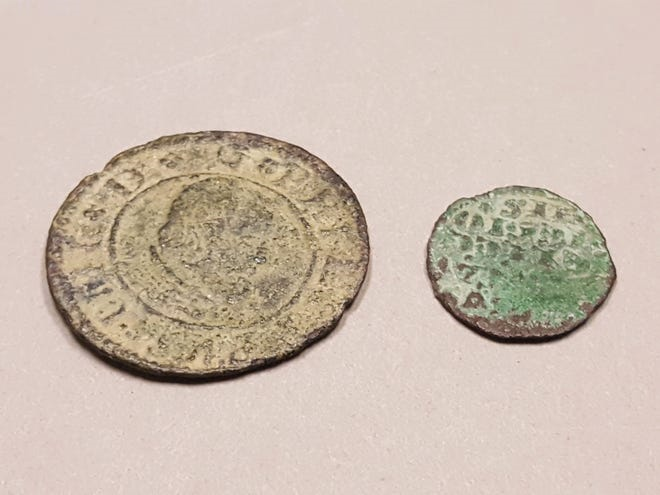You just never know what you might find, and where, and why
It's a mystery: How did two ancient Spanish coins wind up near Lake Powell?
It started with a hiker who plucked two curious objects from a bit of scattered trash, a discovery that launched months of speculation and investigation.
Each wafer-thin bit of metal — one about the size of a quarter, the other a dime — bore strange inscriptions on either side, worn nearly smooth over time. The hiker tucked the coins into his pocket, promising himself to do a little detective work when he returned home.
Today, the mystery of how two ancient Spanish coins wound up near Lake Powell isn’t solved. Though it is a bit clearer.
Late last summer, a Colorado man hiking in the Halls Crossing area on the Utah side of Lake Powell noted something odd at his feet — two small, copper-colored discs that clearly were not part of the natural landscape.
He picked them up for a closer look. Coins, perhaps. And though their markings were barely distinguishable, two things were clear: They were very old, and they were not American.
The hiker, who prefers to remain anonymous, returned home with the objects and did some sleuthing. After researching them online, he reached out to the National Park Service to report his find: two Spanish coins that appeared to be centuries old.
Enter Brian Harmon, archaeologist for Glen Canyon National Recreation Area, in which the coins were found. His history-focused mind began to imagine ways such coins could have wound up in a now-dry part of a canyon that at one time was below the surface of Lake Powell.
But his first question was one of authenticity.
“Where he found them, the way he found them, I was skeptical at first,” Harmon said. Ancient coins don't suddenly appear in places they don't belong, especially in plain sight. “They’re just so unusual.”
The more he studied the detailed images of the coins, the more excited he became because there were only a handful of ways such coins could have found their way to his archaeological backyard.
Harmon’s initial thought was that they were brought by Spanish explorers. However, the coins — one believed to be from the 13th century, the other from the mid-1600s — predated the first known Spanish presence in the area (the Dominguez and Escalante Expedition of 1776) by decades.

Harmon’s second theory, which he found much more tantalizing, was that the coins somehow found their way to Native Americans, who used them in trade.
“I really tried to keep my mind open,” Harmon said. “I was very excited. These aren’t the kinds of things I come across in the normal course of my job.”
Not long after Harmon finally got his hands on the coins in February, he reached out to experts to authenticate the find. Thanks to numismatists in Spain, Harmon learned that the larger coin is a 16 maravedis, dating to 1662-1664. The smaller coin is a dinero from the reign of Alfonso X, dated between 1252 and 1284.
In the meantime, Harmon sent colleagues to the spot where the hiker reported finding the coins. He told them to look for spots from which the coins may have eroded. Based on their ages, the coins should have been buried by layers of sediment. Perhaps they emerged from an alcove, or some other natural deposit.
“In archaeology, what the object is is just as important as where it is found,” Harmon said. “The location can tell us so much. Without that context, it’s almost impossible.”
The reports back from the site were disappointing. There were no clear points of origin, just bits of scattered trash, most likely from passing houseboats.
Then there was the coins' disparate dates. Harmon couldn’t bring himself to believe coins minted centuries apart could have wound up in the same hands, be they Spanish explorers or Native Americans.
That steered Harmon toward his most disappointing, and now likely, theory — that the coins were part of a modern collection that somehow wound up near Halls Crossing.
They most likely were dropped in the area anywhere from a few years to a few decades ago, Harmon said. While it makes little sense for someone to have brought the two coins to Lake Powell, then lose them somehow, it's the most plausible explanation, and one the archaeologist is sticking to until evidence is found to the contrary.
Successful transactions with : MICHAELDIXON, Manorcourtman, Bochiman, bolivarshagnasty, AUandAG, onlyroosies, chumley, Weiss, jdimmick, BAJJERFAN, gene1978, TJM965, Smittys, GRANDAM, JTHawaii, mainejoe, softparade, derryb, Ricko
Bad transactions with : nobody to date
Comments
still a cool find no matter how the coins got there
i have coins for sake at link below (scared of links? get over it)
https://photos.google.com/album/AF1QipPem0okLaTwklm2sKHUFY0-CvO_rQQ7HMHjhcec
Really interesting... and I find no fault with the conclusion....Still leaves the mystery of why they would be brought to such an area and how they could have been lost....Cheers, RickO
Nice!